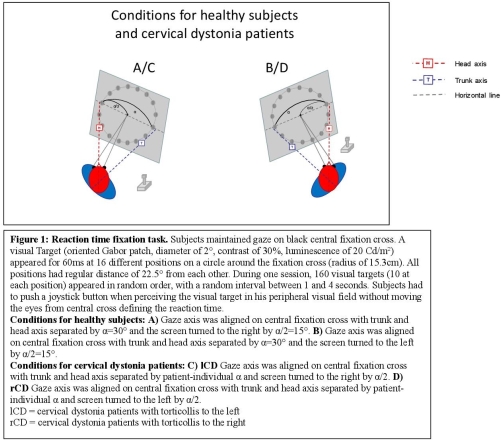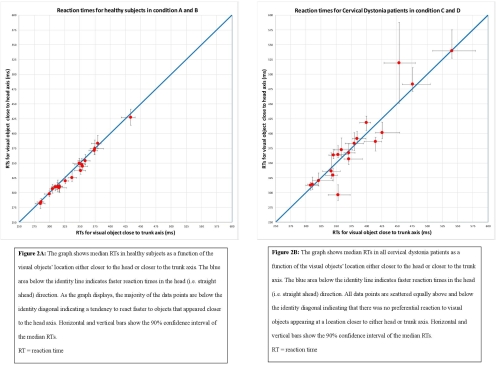Session Information
Date: Thursday, June 23, 2016
Session Title: Dystonia
Session Time: 12:00pm-1:30pm
Location: Exhibit Hall located in Hall B, Level 2
Objective: The goal of our study was to investigate the spatial distribution of visual processing resources in cervical dystonia (CD) patients with a pure left or right torticollis by adapting a new paradigm to assess the preferential perception of the straight-ahead direction.
Background: Recent studies show that humans monitor their straight-ahead direction with special attention even during disengagements of central vision. Healthy human subjects gazing to the side have been reported to respond faster to objects appearing in the peripheral visual field when objects were displayed at a location in the subjects’ straight ahead direction. In CD, egocentric space representation seems to be impaired and visual straight-ahead perception seems to be shifted away from the head midsagittal plane that coincides with the visual straight-ahead of normal subjects.
Methods: 19 CD patients and 20 matched controls performed a reaction time fixation task. Subjects maintained their gaze on a central fixation cross around which visual targets were presented for 60ms. Median reaction time was calculated for targets located in the left and right visual hemifield corresponding either to the straight ahead direction (head axis) or the eccentric direction (trunk axis) depending on the condition (left or right torticollis). 
Results: Healthy controls reacted significantly faster to objects displayed closer to the head axis than those displayed closer to the trunk axis (p<0.00011). CD patients clearly showed no tendency to react faster in either axes (p=0.95). A permutation test confirmed that the observed difference was statistically significant (p=0.0012). 
Conclusions: The results of our study confirm that the straight-ahead direction is monitored with special care in human healthy subjects and that this preference for the straight-ahead position is lost in CD patients. We hypothesize that the observed difference in straight-ahead perception preferences is associated with a dysfunction in the network involved in the modulation of visual information processing. Several studies indicate that the sensori-motor integration of proprioceptive inputs is impaired in CD which may disturb egocentric space representation in affected patients.
To cite this abstract in AMA style:
C.J. Amlang, C. Hubsch-Bonneaud, S. Rivaud-Pechoux, S. Mehdi, A. El Helou, Y. Trotter, J.B. Durand, P. Pouget, M. Vidailhet. Impaired processing of visuo-spatial information in cervical dystonia patients [abstract]. Mov Disord. 2016; 31 (suppl 2). https://www.mdsabstracts.org/abstract/impaired-processing-of-visuo-spatial-information-in-cervical-dystonia-patients/. Accessed April 2, 2025.« Back to 2016 International Congress
MDS Abstracts - https://www.mdsabstracts.org/abstract/impaired-processing-of-visuo-spatial-information-in-cervical-dystonia-patients/
